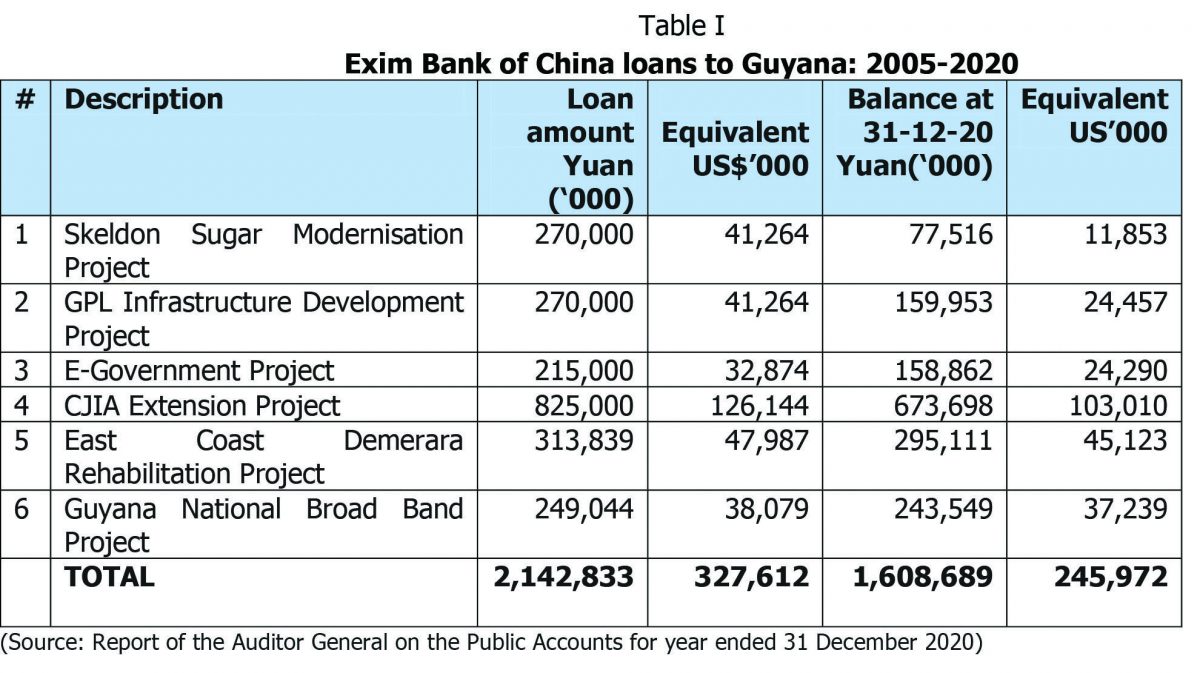In his accountability series in Stabroek News, former Auditor General, Anand Goolsarran has homed in on three projects funded by China’s Exim Bank which he said had failed and left the country with significant debt.
He pointed out that four of the seven infrastructure development projects financed by the Exim Bank of China had run into serious difficulties during their execution stages.
He cited the Skeldon Sugar Modernisation Project; the One Laptop Per Family Project; the Fibre Optic Cable Project; and the Cheddi Jagan International Airport (CJIA) Project. All of these were contracted under former PPP/C administrations. He said that the first three had “failed completely” to deliver in terms of their objectives, outputs, outcomes and impacts, thereby “encumbering the Guyana’s public debt in the tune of US$115.4 million, with little or nothing to show for the expenditure incurred”.
He said that this is in addition to the significant amounts expended as counterpart funding on these projects. In the case of the airport project, he noted that the works are still on-going after ten years, with a revised completion date of 20 June 2022. The original construction cost was estimated at US$150 million. This, he says, has now been revised to around US$200 million.
He also pointed out that Specialty Hospital Project was another failed project contracted under the PPP/C and this time financed by the Exim Bank of India. Apart from the controversy over the award of the contract to Surendra Engineering, the contractor was paid a mobilization advance of US$4.3 million and because of unsatisfactory performance, the contract was terminated. Attempts to recover the amount advanced from the performance bond that was lodged as a guarantee for unsatisfactory performance, were unsuccessful because of a dispute over the bond’s authenticity. This amount is reflected in the public debt of the country.
CJIA
He noted that ten years since the design and construction contract was signed for the CJIA it is yet to be completed. He argued that the main reason for this state of affairs is the absence of feasibility studies prior to the contract award, to determine the precise nature and scope of the works to be undertaken, coupled with a lack of effective supervision as the works progressed.
He pointed out that the contract was awarded in November 2011 in the sum of US$138 million to Chinese construction company, CHEC, a mere ten days before the November 2011 national and regional elections.
“The nation was unaware of this development and only learnt of it from an article carried by the Jamaican Observer newspaper, raising concerns about the apparent secrecy in the award. That apart, no major contract ought to be entered into in the run-up to elections, which has a binding effect to the State, especially during the period of dissolution of Parliament. We had raised this matter when the APNU+AFC did the same during the 20-month period between the no confidence vote and the assumption to office of the current Administration”, he said.
Goolsarran said that there was also no evidence of competitive bidding before the contractor was selected. It would appear it was one of the conditionalities before the loan could have been granted that the works must be undertaken by a Chinese contractor. As he has done before, he pointed out that the Procurement Act is clear that all contracts for procurement of goods, services and works must be awarded based on competitive bidding procedures and the lowest evaluated bids awarded accordingly.
Further, the works did not commence until January 2013, some 13 months after the contract award, with an estimated completion date of August 2015. He contended that there was no evidence of any studies carried out to determine the feasibility and economic viability of a project of this magnitude which includes construction of a new terminal building; acquisition of eight boarding bridges; and installation of other state-of-the-art equipment, such as elevators, escalators, and x-ray scanners, along with flight information and security monitoring systems. In August 2015, he noted that the issue was raised with former Public Infrastructure Minister David Patterson who was unable to shed any light on the matter and suggested that it was the responsibility of the previous Administration to ensure that such studies were undertaken before deciding whether or not to proceed with the Project as configured.
During a visit to the Project in September 2020, Goolsarran pointed out that President Irfaan Ali identified 71 defects that needed to be rectified. The President made it clear that the Government would only accept completed works based on the original contract entered into in 2011. A new deadline for completion of the Project was set for 31 December 2021. The revised completion date is now 20 June 2022.
The One Laptop Per Family and the Fibre Optic Cable projects
Two other major projects that he said failed to deliver are the One Laptop Per Family (OLPF) and Fibre Optic Cable Project. Both of these were financed by the Exim Bank of China – the former from a grant of ¥50.267 million, equivalent to US$7.686 million; the latter, from a loan of ¥215 million, equivalent to US$32.874 million. Numerous irregularities relating to the acquisition, storage and distribution of the computers were uncovered by the auditors, Goolsarran said while the Fibre Optic Cable Project had to be abandoned because numerous problems were encountered in the laying of the cables from Brazil through Guyana’s interior towards the coast.
These failed projects, Goolsarran said, reminds of the statement by Chinese President Xi Jinping after announcing a new round of grants, loans and credit of some US$60 billion for African nations. When asked about allegations that too many poorly thought-through projects were receiving funding from China, he stated that the resources provided should not be spent on vanity projects but in areas that are most needed and that the investments must give ‘both Chinese and African people tangible benefits that can be seen, that can be felt’.
“The problem also appears to be a lack of effective accountability mechanisms to ensure that the funds are spent with due regard to economy, efficiency and effectiveness in the achievement of the stated objectives, outputs and outcomes. For example, in relation to World Bank and IDB loans, one of the conditionalities is for separate financial reporting and independent auditing of the projects within specified deadlines. This is in addition to the submission of periodic reports to these institutions of the status of the projects, financially and otherwise, as well as periodic inspection visits by bank staff”, Goolsarran said.
Skeldon Sugar Modernisation Project
The new factory at Skeldon was part of the Skeldon Sugar Modernisation Project (SSMP), which also involved expanded cane cultivations, the establishment of a refinery and the co-generation of electricity for the national grid. The brainchild of former president Bharrat Jagdeo, the SSMP started in 2003, two years after his first full term as president began.
According to the report of the Commission of Inquiry (CoI) into GuySuCo, the SSMP was initially estimated to cost US$165 million. The project eventually ended up costing US$187 million with funding from the World Bank of US$56 million, Exim China Bank – US$32 million, the Caribbean Development Bank – US$24 million and GuySuCo – US$53 million.
The report noted that GuySuCo’s contribution of US$53 million was intended to come from the sale of its land around Guyana. However, this did not materialise and the sugar corporation used its own resources thereby depleting its working capital. The escalation in the cost from US$165 million to US$187 million was also funded out of GuySuCo’s own resources.
The China National Technology Import and Export Corporation (CNTIC) was contracted to build the new Skeldon factory at a cost of US$110 million, which was part of the SSMP US$187 million. CNTIC underperformed and the then government ignored recommendations by Booker Tate a UK-based management firm that was hired to look at the design and oversee the implementation of the SSMP, to terminate that contract.
The factory was commissioned in August 2009 amid much hype with the previous administration saying that it would increase sugar production. Jagdeo had said that the factory was designed to have the capability to produce sugar for US 12 cents per pound. The cost of production was way above this and the factory never came anywhere near to producing the promised 110,000 tonnes of sugar per annum. It was later shuttered by the APNU+AFC administration.






